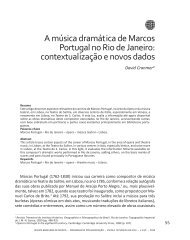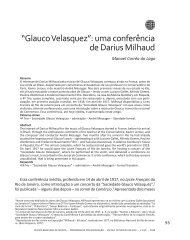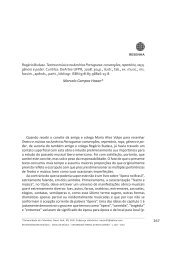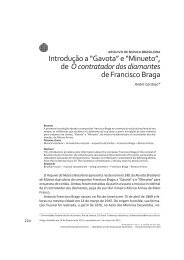Versão Digital - UFRJ
Versão Digital - UFRJ
Versão Digital - UFRJ
You also want an ePaper? Increase the reach of your titles
YUMPU automatically turns print PDFs into web optimized ePapers that Google loves.
22<br />
century, and still found in collections around the world. Many of these collections are<br />
very important and quite well known. Thus, King Frederick VI of Denmark, in approximately<br />
1820, ordered a significant collection of Italian manuscripts sent to him as representative<br />
of works that could be performed in his realm: this collection is still found in the Royal<br />
Library in Copenhagen. And the collection includes many works that are known from very<br />
few other sources, since it features works popular during the 1810s. In some cases these<br />
manuscripts have textual importance: they include, for example, some little known works<br />
by Rossini, such as Ciro in Babilonia, Adelaide di Borgogna, and Edoardo e Cristina. No<br />
one has yet made a complete study of these sources, so we cannot say very much about<br />
their significance as a group, but the Rossini operas, at least, have all been photocopied<br />
and are being used currently for textual work on these titles. 15<br />
In Russia, on the other hand, there has been relatively little study of Italian<br />
manuscripts, even though we know that several important Italian composers spent<br />
considerable periods of time working with Russian theaters, composers such as Giovanni<br />
Paisiello, Domenico Cimarosa, Alessandro Nini, and Giuseppe Verdi. In many cases<br />
important sources (some of them autograph) exist in the archives of the Marinsky Theater<br />
and in other Russian libraries. Indeed in the case of an opera first performed at the Marinsky<br />
Theater, such as Verdi’s La forza del destino of 1861-1862, the theater’s well-known<br />
tendency to have kept everything has proven invaluable. 16 On many of the performing<br />
parts we find entries in Verdi’s own hand, annotations written while he was rehearsing<br />
the music with individual singers. 17 It is only from these performing materials, for example,<br />
that we learn that the famous Prayer that forms part of the Scena Osteria in Act II was<br />
originally accompanied only by an arpeggiating clarinet and by pizzicato bass notes in the<br />
violoncelli and contrabbassi. In the printed edition of the opera and the autograph<br />
manuscript, however, there are also wind parts duplicating the choral material of the<br />
Prayer. Because of the nature of the parts, we know for certain that these doubling wind<br />
parts were added during the rehearsal period, presumably to keep singers in tune on<br />
what is a long passage with very little accompaniment. 18 This clearly has significant<br />
ramifications for today’s editions and for possible interpretations of them in contemporary<br />
performance.<br />
Unfortunately, few collections of this importance exist in Italy itself. That lack is<br />
in part a product of the conditions that prevailed in opera archives and of the many fires<br />
that destroyed whatever collections might have once existed, but it is also in part related<br />
to the nature of the social structures that grew up around the performance of opera in<br />
nineteenth-century Italy. One of the ways in which publishers succeeded in rendering<br />
their calling economically viable during this period was to make available performing<br />
materials exclusively by rental agreements, whereby theaters needed to work through<br />
publishers to obtain materials from which to perform. 19 During the first two decades of<br />
the nineteenth century Italian publishers did not even print entire vocal scores of operas.<br />
When it became clear that foreign publishers, particularly those working in Germany,<br />
Austria, and France, were dominating this market, Italian publishers soon began to catch<br />
up. While during the 1810s they published only favorite extracts from new operas, by the<br />
...........................................................................<br />
15 Let me thank Knud Arne Jürgesen, who facilitated my work with these sources.<br />
16 My use of the library was considerably assisted by the kind permissions obtained from the musical director,<br />
Valery Gergiev. I also wish to thank the staff of the Archive for its many kindnesses.<br />
17 Thus, Verdi himself added the revised cabaletta of Don Carlos’ third-act aria, “Urna fatal,” in the vocal part of<br />
Don Carlos. Originally the vocal part had only an earlier version of this cabaletta.<br />
18 The wind parts originally had rests in these measures. The doubling wind parts were added by means of<br />
collettes in the parts, some of which were pasted in on all four sides, so that it is impossible to read what was<br />
originally present, but some of which were pasted in on only two sides, so that it is simple to read the rests that<br />
were originally in the parts.<br />
19 The process is well described in Claudio Sartori, Casa Ricordi 1808-1858 (Ricordi: Milan, 1958).<br />
Atualidade da Ópera - Série Simpósio Internacional de Musicologia da <strong>UFRJ</strong>






